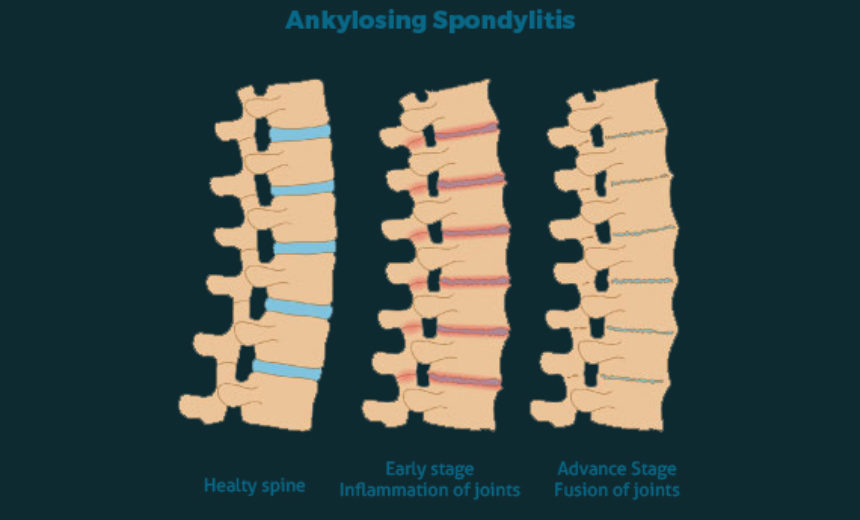Ankylosing Spondylitis: Understanding the Disease, Latest Research, and Effective Treatments (Allopathic & Ayurvedic)

Ankylosing spondylitis is a chronic, inflammatory disease that primarily affects the spine and sacroiliac joints. It is a type of arthritis that causes inflammation and stiffness in the joints, which can lead to permanent fusion of the vertebrae, resulting in a rigid and inflexible spine.
The exact cause of ankylosing spondylitis (AS) is unknown, but it is believed to be a combination of genetic and environmental factors. People with a family history of the disease are more likely to develop ankylosing spondylitis.
Ankylosing spondylitis is often diagnosed in young adults between the ages of 17 and 35 and is more common in men than women. Common symptoms include lower back pain, stiffness, fatigue, and loss of mobility. The pain and stiffness usually improve with activity, but can worsen after periods of inactivity.
The diagnosis of ankylosing spondylitis is based on a combination of clinical examination, medical history, and imaging tests. The most commonly used tests for diagnosing ankylosing spondylitis include X-rays, magnetic resonance imaging (MRI), and blood tests for the presence of certain inflammatory markers.
The latest research on ankylosing spondylitis has been focused on developing new and more effective treatments for the disease. One promising area of research is the use of biologic agents, such as tumor necrosis factor (TNF) inhibitors, which work by blocking the action of TNF, a substance in the body that promotes inflammation.
Another area of research is the development of new drugs that target interleukin-17 (IL-17), a substance in the body that is involved in the development of AS. Some studies have found that IL-17 inhibitors can be effective in reducing symptoms and slowing the progression of the disease.
Additionally, researchers are also looking at the role of genetics in the development of AS. Recent studies have identified specific genetic markers that are associated with an increased risk of developing the disease. This information can be used to develop new treatments and to better understand the underlying causes of the disease.
In terms of non-pharmacological treatments, physical therapy and exercise have been found to be effective in managing the symptoms of ankylosing spondylitis. A well-designed exercise program, combined with appropriate medication and other treatments, can help to relieve pain, improve flexibility and mobility, and slow the progression of the disease.
There is currently no cure for ankylosing spondylitis, but various treatments can help manage the symptoms and slow the progression of the disease. The most commonly used allopathic treatments for ankylosing spondylitis include nonsteroidal anti-inflammatory drugs (NSAIDs), disease-modifying anti-rheumatic drugs (DMARDs), and biologic agents. These drugs work by reducing inflammation and slowing the progression of the disease.
In addition to allopathic treatments, there are also various ayurvedic treatments that have been found to be effective in managing the symptoms of AS. Ayurvedic treatment for ankylosing spondylitis focuses on reducing inflammation, relieving pain, and improving mobility. Some of the most commonly used ayurvedic treatments for ankylosing spondylitis include:
Herbs: Ayurvedic practitioners often use herbs such as turmeric, ginger, and boswellia to reduce inflammation and relieve pain. These herbs have been used for centuries to treat various forms of arthritis and have been found to be effective in managing the symptoms of AS.
Massage: Massage is another important aspect of ayurvedic treatment for ankylosing spondylitis. Massage helps to relieve pain and improve flexibility by promoting blood flow and reducing muscle tension. It is often used in combination with other treatments to maximize its effectiveness.
Yoga: Yoga is another important aspect of ayurvedic treatment for ankylosing spondylitis. Yoga helps to improve flexibility, mobility, and posture, and can also help to reduce stress and relieve pain. A well-designed yoga program, combined with other treatments, can help to slow the progression of the disease.
Diet: A balanced and nutritious diet is also important in managing the symptoms of ankylosing spondylitis. An ayurvedic diet is often recommended for people with the disease, as it helps to reduce inflammation, improve digestion, and promote overall health.
In addition to these treatments, ayurvedic practitioners may also recommend other complementary therapies, such as meditation and deep breathing exercises, to help manage the symptoms of ankylosing spondylitis.
It is important to note that ayurvedic treatments should be used under the supervision of a qualified practitioner. Some herbs and treatments may interact with conventional medications, so it is important to inform your healthcare provider about any ayurvedic treatments you are using.
In conclusion, ankylosing spondylitis is a chronic, inflammatory disease that affects the spine and sacroiliac joints. While there is currently no cure, various treatments can help manage the symptoms and slow the progression of the disease. Whether you choose allopathic or ayurvedic treatments, it is important to work closely with your healthcare provider to develop a treatment plan that is right for you.



